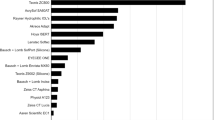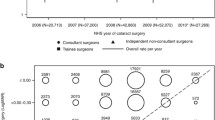Abstract
Via meta-analysis, we assessed the effect of pediatric cataract surgery with posterior continuous curvilinear capsulorhexis (PCCC) with or without anterior vitrectomy (AV) on the incidence of after cataract. Group 1 consisted of pediatric cataract surgery with or without PCCC. Group 2 consisted of pediatric cataract surgery with PCCC with or without AV. The pooled odds ratio of after cataract in Group 1 was 0.21; in Group 2 it was 0.13. Pediatric cataract surgery with PCCC is superior to single cataract surgery in preventing the incidence of after cataract.




Similar content being viewed by others
References
Scott RL, Arlene VD. Infantile cataracts. Surv Ophthalmol 1996;40:427–458
Daniel V, Taylor A, Paul RE. General Ophthalmology, 15th ed. Beijing: People’s Medical Publishing House, 2001, p. 162
Schaumberg DA, Dana MR, Christen WG, et al. A systematic overview of the incidence of posterior capsule opacification. Ophthalmology 1998;105:1213–1221
Buckley EG, Klombers LA, Seaber JH, et al. Management of the posterior capsule during pediatric intraocular lens implantation. Am J Ophthalmol 1993;115:722–728
Dahan E, Salmenson BD. Pseudophakia in children: precautions, technique, and feasibility. J Cataract Refract Surg 1990;16:75–82
Moher D, Cook DJ, Eastwood S, et al. Improving the quality of reports of meta-analyses of randomised controlled trials: the QUOROM statement. Quality of Reporting of Meta-analyses. Lancet 1999;354:1896–1900
Moss M, Wellman DA, Cotsonis GA. An appraisal of multivariable logistic models in the pulmonary and critical care literature. Chest 2003;123:923–928
Cochrane Reviewers’ Handbook 2005: http://www.cochrane.dk/cochrane/handbook/
Rosenthal R, Kleid JJ, Cohen MV. Abnormal mitral valve motion associated with ventricular septal defect following acute myocardial infarction. Am Heart J 1979;98:638–641
Luo XL, Xu JT, Huang JT, et al. Comparing after cataract formation in children having undergone three different cataract surgeries. Chin J Ocular Trauma 2004;26:21–23
Raina UK, Mehta DK, Monga S, et al. Functional outcomes of acrylic intraocular lenses in pediatric cataract surgery. J Cataract Refract Surg 2004;30:1082–1091
Vasavada AR, Trivedi RH, Nath VC. Visual axis opacification after AcrySof intraocular lens implantation in children. J Cataract Refract Surg 2004;30:1073–1081
Lei Z, Ding XQ, Gao YJ. Preventing secondary cataract in congenital cataract operation. J Cataract Refract Surg 2004;26:91–92
Vasavada A, Desai J. Primary posterior capsulorhexis with and without anterior vitrectomy in congenital cataracts. J Cataract Refract Surg 1997;23(Suppl 1):645–651
Zhu ZC, Yuan HY, Sun SQ, et al. Surgery prevention against posterior capsular opacity after IOL operation in children under 6. Acta Universitatis Medicinalis Anhui 2002;37:474–475
Knight-Nanan D, O’Keefe M, Bowell R. Outcome and complications of intraocular lenses in children with cataract. J Cataract Refract Surg 1996;22:730–736
Apple DJ, Solomon KD, Tetz MR, et al. Posterior capsule opacification. Surv Ophthalmol 1992;37:73–116
Hiles DA, Hered RW. Modern intraocular lens implants in children with new age limitations. J Cataract Refract Surg 1987;13:493–497
Markham RHC, Bloom PA, Chandna A, et al. Results of intraocular lens implantation in pediatric aphakia. Eye 1992;6:493–498
Morgan KS, Karcioglu ZA. Secondary cataracts in infants after lensectomies. J Pediatr Ophthalmol Strabismus 1987;24:45–48
Nishi O. Fibrinous membrane formation on the posterior chamber lens during the early postoperative period. J Cataract Refract Surg 1998;14:73–77
Tablante RT, Lapus JV, Cruz ED, et al. A new technique of congenital cataract surgery with primary posterior chamber intraocular lens implantation. J Cataract Refract Surg 1988;14:149–157
Fenton S, O’Keefe M. Primary posterior capsulorhexis without anterior vitrectomy in pediatric cataract surgery: Longer-term outcome. J Cataract Refract Surg 1999;25:763–767
Raina UK, Gupta V, Arora R, et al. Posterior continuous curvilinear capsulorhexis with and without optic capture of the posterior chamber intraocular lens in the absence of vitrectomy. J Ped Ophthalmol Strab 2002;39:278–287
Zetterström C, Kugelberg U, Oscarson C. Cataract surgery in children with capsulorhexis of anterior and posterior capsules and heparin-surface-modified intraocular lenses. J Cataract Refract Surg 1994;20:599–601
Author information
Authors and Affiliations
Corresponding author
Additional information
Drs. Jian, Xiaolei, and Rongdi are from the Third Military Medical University, Department of Ophthalmology, Daping Hospital, Chongqing, China, 400042.
The authors have stated that they do not have a significant financial interest or other relationship with any product manufacturer or provider of services discussed in this article. The authors also do not discuss the use of off-label products, which includes unlabeled, unapproved, or investigative products or devices.
Using meta-analysis, the authors assessed the effect of pediatric cataract surgery with posterior continuous curvilinear capsulorhexis with or without anterior vitrectomy on the incidence of after cataract.
Rights and permissions
About this article
Cite this article
Xiaolei, Y., Rongdi, Y. & Jian, Y. The Incidence of After Cataract Following Three Different Types of Cataract Surgery in Children: A Meta-Analysis. Ann Ophthalmol 39, 123–127 (2007). https://doi.org/10.1007/s12009-007-0003-z
Received:
Accepted:
Published:
Issue Date:
DOI: https://doi.org/10.1007/s12009-007-0003-z




